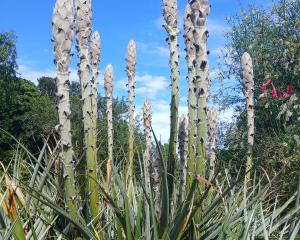After seeing talent agent Adam Isaacs' bedroom terrace garden for the first time, you might think that he is blessed with a green thumb. But you'd be wrong.
True, the staghorn fern on the wall and the bromeliad below, as well as the fountain grass and short green yucca ferns that surround his serene Balinese Buddha, look particularly perky.
And his timber bamboo, split-leaf philodendron and red banana tree are full and lush-looking.
Ditto the red variegated succulents that are bursting the confines of their low-slung ceramic planter.
"It's all fake," the Los Angeles resident says, proud of his manicured garden, where every plant is always in its prime.
"Friends and clients come over and tell me how beautiful my garden is - they have no idea it's not real," he says with a laugh.
"I love to look at them - but I've never been great with plants," he says. "The huge pot with the Buddha originally was filled with water hyacinths. They'd look good for a week then rot and die."
At one point in his busy schedule Isaacs did tend 15 phalaenopsis.
"The white orchids are my favourites. I spent every Saturday morning watering them, feeding them orchid food, caring for them. But it was just too much maintenance; I decided I'd rather be doing yoga."
Before going to London on a business trip last year, Isaacs called in a good friend, florist George Woods, to take him up on a curious offer.
"He told me that the new artificial plants looked amazingly real and why didn't I do a 100% faux garden?" Isaacs says.
"Faux plants are very lightweight, and you don't have any dirt to deal with," explains the florist, who arranged the plants in the agent's existing containers, filling them with packing popcorn topped with a 5cm-thick solid layer of plastic foam.
Coloured crushed glass, river rocks and sheet moss surround the plants' bases. The result is amazingly real.
Woods has two maxims: "First, don't plant anything that wouldn't normally grow in the place you select. If it's [winter], don't fill your terrace with sunflowers. And secondly, you need to get hands-on with artificial plants."
In an effort to make the faux plants appear as realistic as possible, Woods did just that - cutting, thinning, bending and folding them into lifelike simulations.
"If plants are too uniform, they look fake," he says. "Mother Nature just doesn't grow them that way."
The artificial plants cost three times as much as real ones, but Woods points out that they don't need to be tended, and they won't die and need to be replaced.
"You'll eventually come out ahead," he says. "Plus, they should look good for 10 to 15 years."
Tips
•Use only artificial versions of plants that would naturally grow if they were real in the space you select. Otherwise, they will look out of place.
•Don't display things out of season: no sunflowers in winter or irises and tulips in autumn.
•Take a walk in nature to observe how plants really grow.
•Move your hands through the plants to give them a more natural shape: Thin out the leaves, bend the stems, fold the leaves. Make them as natural-looking as possible.
•Create a collection of pots in various shapes, sizes and colours. You don't want it to look as if you bought them all on the same day.
•Buy plants with different shapes, textures and complementary hues for visual interest - just like you would for a real garden.
•If an artificial plant doesn't fool you the first time you see it, move on to one that does.















